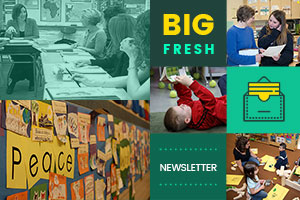It is the greatest truth of our age: Information is not knowledge.
Caleb Carr
Yesterday I searched online for a cornbread recipe. In the process I was reminded again of how every hamlet in the U.S. has some mom aspiring to be a lifestyle blogger, with a dedicated following checking in on their tips for everything from rearranging the living room furniture to making your own shampoo. And recipes are a big part of the equation, as I discovered when I clicked on a few different links for world’s best cornbread.
The problem is these bloggers all follow the same formula. If you want a simple cornbread recipe, you have to scroll through six paragraphs (each with a highly stylized photo of an ingredient) extolling the joys of cornbread and how it fits into their yummy life, building your anticipation for the recipe as they explain that it’s now the only cornbread her kids Jaden, Colton, and Brianna will eat.
Maybe it’s a generational thing, with younger folks enjoying all the photos of flour sprayed artfully across a cutting board or toddlers prancing among fields of spring wildflowers in white linen. Me? When I search for a good cornbread recipe, that’s what I want.
Yet there obviously is some reward to the delayed recipe gratification script since so many bloggers follow it. The formula increases your time at any site, and often requires an extra click to get to the recipe and reviews. Those are metrics a blogger might care about if she’s trying to “build her brand.” The problem is that they thwart the main goal of visitors to the site.
I remember years ago when “turn-and-talks” were becoming popular in classrooms. I went to a presentation where the consultant explained that if you didn’t have a turn-and-talk for students at least every six minutes in your classroom, you weren’t fostering enough conversation. The teachers I was with quickly calculated that they would need to have students turn and talk at least 40 times a day. It was a formula with easy metrics, but was it really a recipe for success? And would it be good talk, especially for introverts or those who are slower to formulate thoughts and share them? Sometimes the activities that are simplest to assess have almost nothing to do with goals.
Teaching sometimes feels like a search for the best recipes from peers, and there is nothing wrong with that. We all stand on the shoulders of others, and I loved that jolt of excitement I got when I heard a new idea at a conference and couldn’t wait to get back to my classroom to try it.
But sometimes the best learning comes from upending the formulas you’ve used for months or years to see what happens. Try a week of only reading aloud poems, even during transitions when you don’t normally have read alouds. What would happen if you tried a minilesson at the end of your workshop block, instead of the start? Heresy! How would students be able to apply the skills you’re discussing? But maybe adifferent sort of learning would go on, with a different change to assess.
The truth is, I almost never revisit any of those blogs that follow that same six paragraphs, six photos cha-cha-cha formula for presenting recipes. There is something tired and inauthentic about such a conscious attempt to meet goals that aren’t mine. The classrooms I like visiting the most also have a formula that follows all the principles about workshops and instruction I believe in, yet somehow manage to be uniquely their own.
In the end, I used the recipe on the canister of cornbread, and it was great. Very retro of me.
This week we look at how to keep assessment from overwhelming best practices in literacy. Enjoy!
Brenda Power
Founder, Choice Literacy

Ruth Ayres explains how data can make students and teachers feel empowered or deflated—so much depends on what you are looking for and how you present it.
“How do you know what level they have selected?” a visitor asks Bitsy Parks as she observes during a first-grade independent reading period. “I don’t,” Bitsy responds, and explains why not assessing students’ reading progress by the level of the book they are reading is a beautiful thing.
Pernille Ripp simplifies assessment with a single-point rubric, and finds it helps students reflect on their learning in a deeper way.
We hope you’ll make our online course program part of your personal improvement plan this spring. Instructors include Ruth Ayres, Katherine Sokolowski, Dana Murphy and many others. Topics in the self-paced classes include student research projects, smarter reading conferences, and better coaching cycles. Members receive discounts of 20-40% on course fees, and nonmembers receive three-month trial memberships to the website.

New members-only content is added each week to the Choice Literacy website. If you’re not yet a member, click here to explore membership options.
After encountering so many students bedraggled by the pressures of testing and producing high scores, I began to worry that my students believed their purpose at school is to test well. With that insight, Christy Rush-Levine realized she had to help her students find a different “why” for their time in her classroom.
Suzy Kaback marvels at a very young learner who is a “secret reader,” and this leads her to reassess the value of constantly celebrating new skills in school communities.
In this week’s video, Franki Sibberson leads a minilesson in her fifth-grade classroom to help students design their own lessons. She analyzes her own process, and students then assess what goes into a high-quality minilesson.
You can browse dozens of features about assessment in the Assessment Tools section of the redesigned website.

Lead Literacy now has a new home as the Leaders Lounge at Choice Literacy. We’ll be posting the new content updates here in the Leaders Lounge section of the Big Fresh newsletter.
David Pittman humorously conveys the dread he experiences when he is assigned to lead an inservice session focused on data. He then finds creative ways to reframe the discussion.
In this coaching minute video, Jen Schwanke talks through the tricky work of making sure literacy specialists, coaches, and classroom teachers have the time and structure they need to collaborate well around students and data.
New PD2Go: This workshop with video and writing from Melanie Meehan helps teachers use anchor charts and exit slips to assess the quality of their teaching in the midst of instruction.
Beth Moore shares some practical and generous tips on how to be a better colleague.
Quote It:
I’ve been absolutely terrified every moment of my life – and I’ve never let it keep me from doing a single thing I wanted to do.
Georgia O’Keeffe
That’s all for this week!



